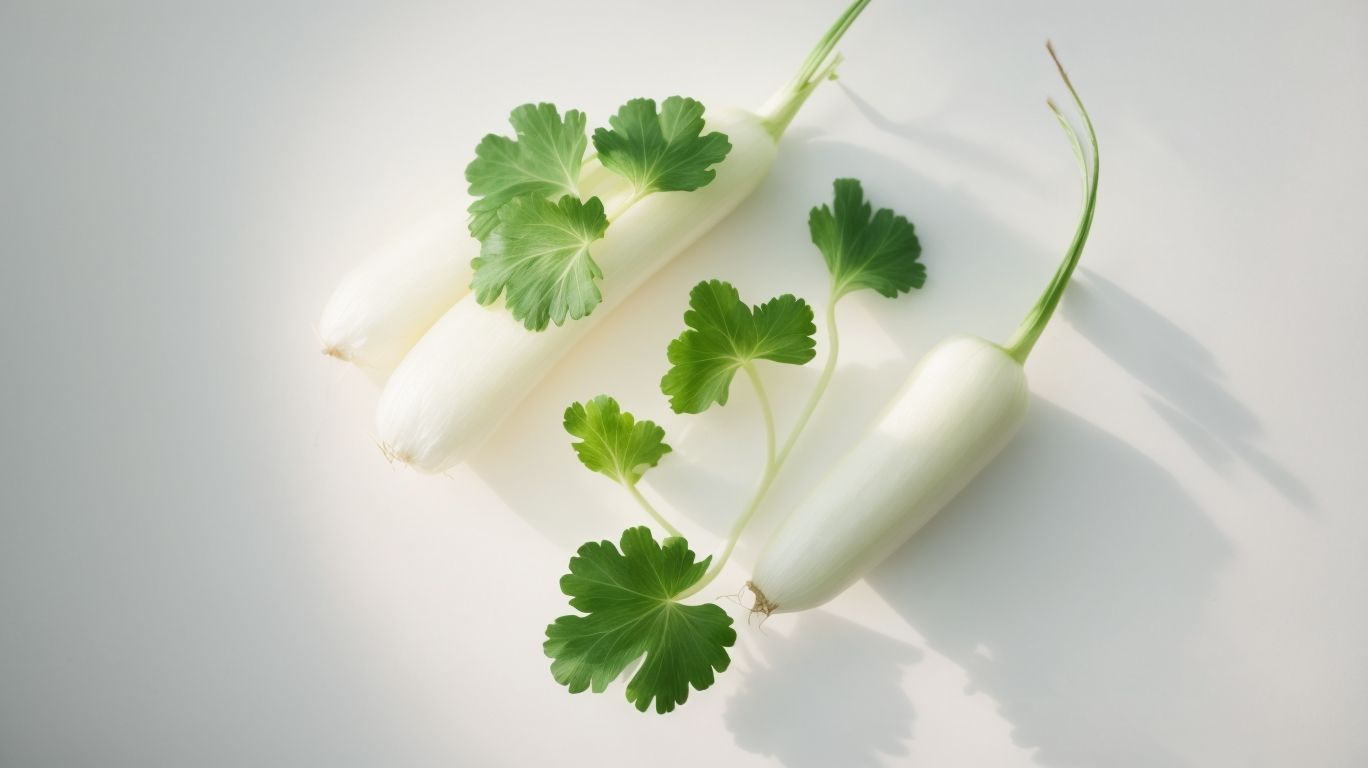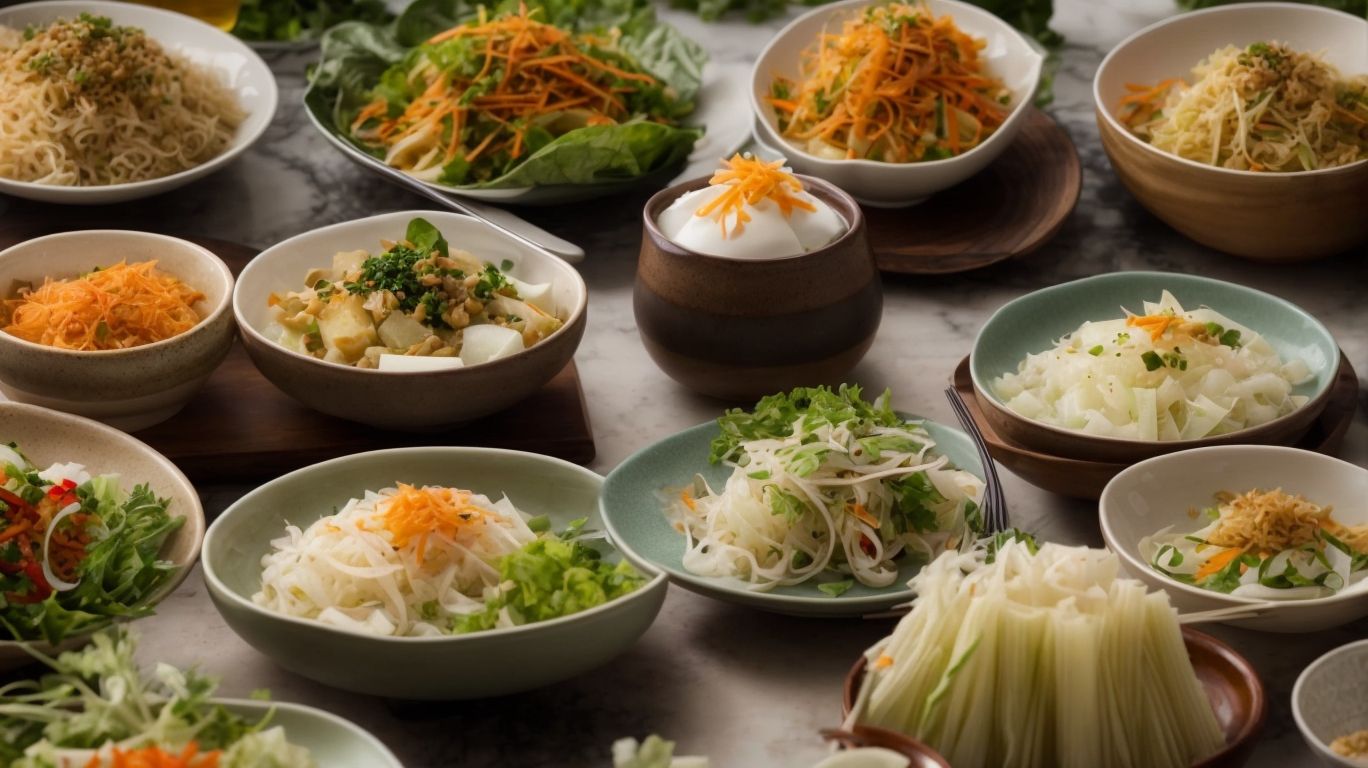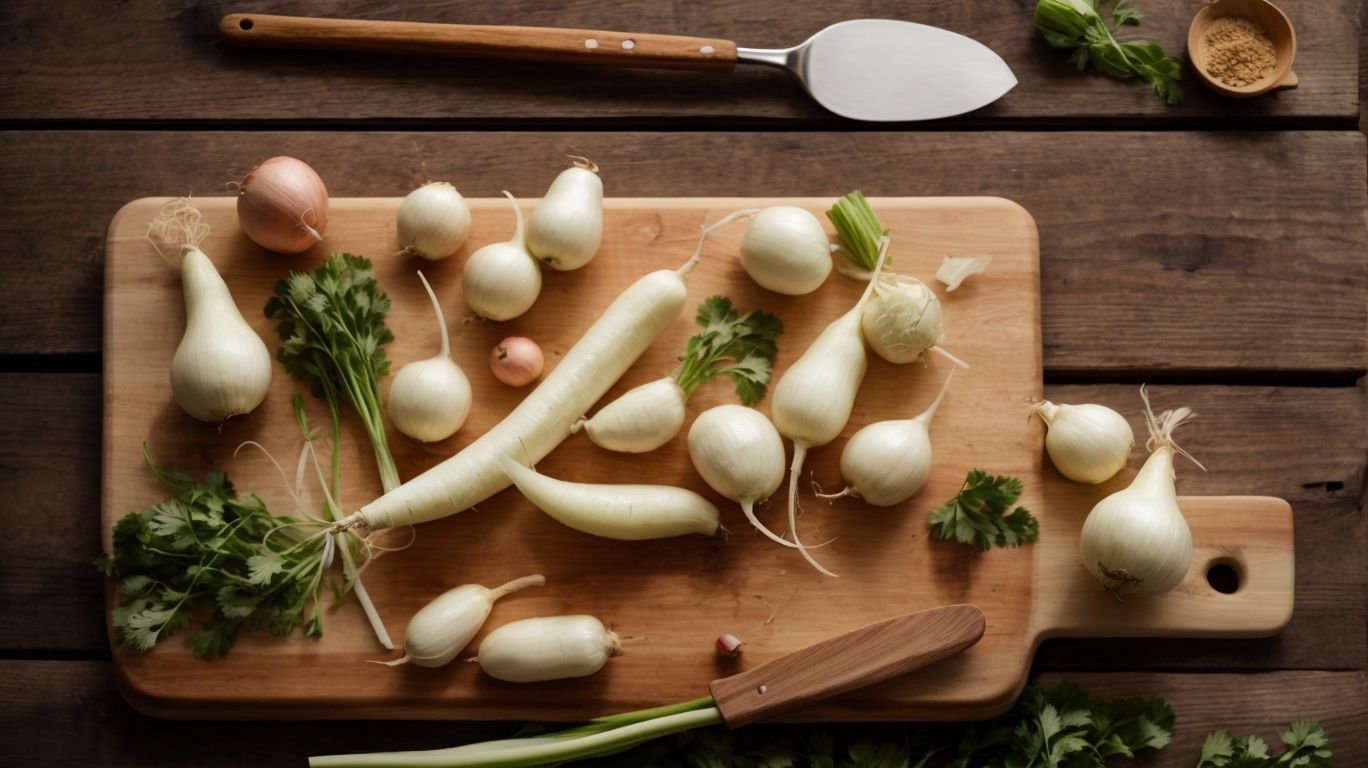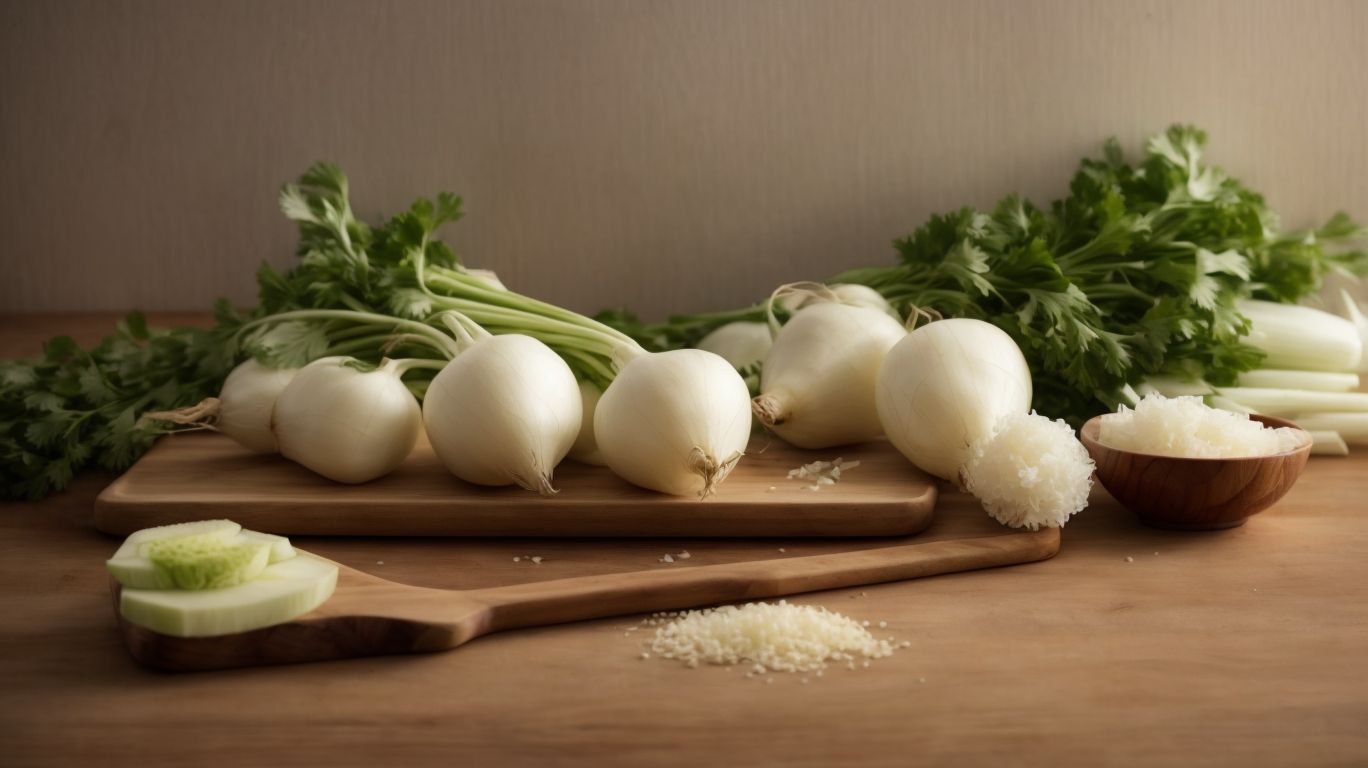How to Cook With Daikon?
Are you looking for a new ingredient to spice up your cooking routine?
Discover everything you need to know about daikon, a versatile root vegetable.
Learn where to find it, its nutritional values, and various cooking methods. Whether you’re a seasoned chef or cooking novice, daikon can add a unique flavor and texture to your dishes.
Dive into the delicious world of cooking with daikon!
Key Takeaways:
What is Daikon?
Daikon, also known as Japanese or Chinese radish, is a versatile and nutritious winter radish commonly used in East Asian cuisine.
With its mild flavor and crunchy texture, daikon is a staple ingredient in dishes such as stir-fries, soups, pickles, and salads across Japan, China, Korea, and other East Asian countries.
One of the key features of daikon is its ability to absorb flavors, making it a popular choice for enhancing the taste of various dishes.
Along with its culinary uses, daikon is also valued for its nutritional benefits, being rich in vitamin C, fiber, and potassium.
Where Can You Find Daikon?
Daikon, a staple Chinese winter radish, can be easily found in local supermarkets, Asian grocery stores, and even specialty markets like those in Hokkaido.
When selecting daikon, look for firm roots that are heavy for their size, indicating freshness. Avoid any that have soft spots or blemishes.
To store daikon, you can wrap it in a damp paper towel and place it in a plastic bag in the refrigerator, where it can last for up to two weeks.
Utilizing daikon in your cooking can add a unique flavor to dishes like salads, stir-fries, and soups.
What are the Nutritional Values of Daikon?

Credits: Poormet.Com – James Robinson
Daikon is a nutrient-rich vegetable packed with essential minerals such as calcium, folate, potassium, magnesium, and vitamin C, offering numerous health benefits.
Daikon also provides a good source of fiber, which aids digestion and promotes a healthy gut microbiome. This vegetable is low in calories and high in water content, making it a great choice for weight management and hydration.
In traditional medicine, daikon is believed to have detoxifying properties that help cleanse the body and support liver function. Its high content of antioxidants like vitamin C and flavonoids further boosts the immune system and reduces inflammation, potentially lowering the risk of chronic diseases.
How to Prepare Daikon for Cooking?
Preparing daikon for cooking involves peeling, cutting, and addressing any bitterness, ensuring a fresh and flavorful addition to your dishes.
When handling daikon, especially those sourced from regions like Hokkaido, it’s essential to start by washing the root thoroughly to remove any dirt. Once cleaned, the next step is to peel the outer skin using a vegetable peeler or a sharp knife. The skin is slightly bitter, so removing it helps to enhance the overall taste. After peeling, consider cutting the daikon into preferred shapes – slices, cubes, or matchsticks. To reduce the bitterness, you can sprinkle salt over the cut pieces and let them sit for 10-15 minutes before rinsing. This technique helps to draw out excess moisture and mellow the flavor.
Peeling and Cutting Daikon
When peeling and cutting daikon, it is essential to utilize proper techniques to maintain its shape and texture for various culinary applications.
One crucial technique when peeling daikon is to always start by trimming off the top and bottom ends to create a stable base for cutting. Next, using a sharp knife, carefully slice off the skin in thin strips, ensuring to remove only the outer layer to preserve the crisp texture beneath. Be mindful not to take off too much flesh in the process, as the daikon’s flavorful and juicy interior should be preserved.
Regarding cutting daikon, the size and shape can greatly impact the dish’s aesthetics. For classic matchstick cuts often used in salads or stir-fries, cut the daikon into thin slices and then into matchstick-shaped pieces. For rounds or cubes, aim for consistent thickness to ensure even cooking.
Removing the Bitterness of Daikon
To remove the bitterness of daikon before cooking, techniques like soaking in cold water or blanching can help enhance its flavor profile.
Soaking daikon in cold water is a simple yet effective method to lessen its bitterness. The cold water helps draw out some of the harsh flavors, leaving behind a milder taste that blends well with other ingredients in dishes.
Blanching, on the other hand, involves briefly boiling the daikon before cooking it further. This process not only reduces bitterness but also helps retain its natural crunchiness, adding a delightful texture to your culinary creations.
What Are the Different Ways to Cook with Daikon?

Credits: Poormet.Com – Kenneth Anderson
There are numerous culinary possibilities when it comes to cooking with daikon, including stir-fry, soup, pickles, and chips, each offering a unique and delightful flavor profile.
Daikon, also known as Japanese radish, brings a refreshing crunch and a slightly peppery kick to dishes. When stir-fried, daikon caramelizes beautifully, adding a subtle sweetness to the dish. In soups, daikon absorbs the flavors of the broth, becoming tender and juicy. Pickled daikon offers a tangy, sour contrast that complements rich dishes perfectly. And if you’re looking for a crispy snack, daikon chips can be seasoned in various ways to satisfy your cravings.
Daikon Stir-fry
Daikon stir-fry is a popular Chinese dish that combines the crunchy texture of daikon with savory flavors from ingredients like soy sauce, creating a delicious and healthy meal.
Traditionally, this dish is cooked using a hot wok to quickly stir-fry the daikon with garlic, ginger, and a medley of vegetables. The key to achieving the perfect stir-fry lies in the technique of cooking over high heat and constant tossing to evenly distribute the flavors.
What makes daikon stir-fry so appealing is its versatility. You can customize it by adding protein sources like chicken, tofu, or shrimp, enhancing the dish with your preferred seasonings and spices.
Along with its delightful taste, daikon stir-fry offers numerous health benefits. Daikon is a low-calorie vegetable packed with vitamins, minerals, and dietary fiber, making it a great choice for those looking to maintain a balanced diet.
Daikon Soup
Daikon soup, simmered to perfection and garnished with fresh herbs, is a comforting winter dish that highlights the natural sweetness of this versatile winter radish.
Simmering the daikon soup slowly allows the flavors to meld together, creating a rich and savory broth that warms you from the inside out. The longer it simmers, the more depth of flavor it develops, making it the perfect meal for chilly days. Pairing the soup with crispy fried shallots and a drizzle of sesame oil adds a delightful crunch and nutty aroma that complements the root vegetable’s mild taste.
During the colder months when daikon is in abundance, this soup becomes a go-to choice for nourishing and soul-warming meals. The high water content in daikon also makes this soup hydrating and light on the stomach, ideal for supporting immune health during the winter season.
Daikon Pickles
Daikon pickles, marinated in tangy vinegar and spices, are a staple in East Asian culture, known for their crunchy texture and robust flavors.
Authentic daikon pickles start with fresh, crisp daikon radishes cut into thin slices or matchsticks, then submerged in a mixture of vinegar, soy sauce, sugar, and ginger for a few hours to develop their distinct tangy and savory profile.
These pickles are not only a delicious accompaniment to rice dishes but also serve as a palate-cleansing side dish that enhances the overall dining experience.
The process of marinating daikon in these flavors not only preserves the radish but also infuses it with a medley of tastes that complement various dishes, making it a versatile ingredient in Asian cooking.
Daikon Chips
Daikon chips, thinly sliced and baked to a crispy perfection, offer a crunchy and flavorful alternative to traditional potato chips, ideal for healthy snacking.
When making these nutritious snacks, it is crucial to bake the daikon slices at a low temperature for a longer time to achieve the desired crispiness without burning them. Seasoning plays a vital role in enhancing the taste profile of daikon chips; options like sea salt, black pepper, paprika, or even a sprinkle of Parmesan cheese can elevate the flavor experience.
Daikon, a type of radish, is packed with essential nutrients like vitamin C, fiber, and antioxidants, making it a guilt-free snack choice. These chips provide a satisfying crunch without the excess calories and unhealthy fats typically found in traditional snacks.
What Are Some Tips for Cooking with Daikon?
When cooking with daikon, consider pairing it with complementary ingredients and adjusting cooking times based on different dishes to enhance its natural flavors and textures.
-
For a refreshing side dish, try combining thinly sliced daikon with soy sauce, rice vinegar, and a sprinkle of sesame seeds. This Asian-inspired salad brings out the crispness of daikon while adding a burst of umami flavor.
-
To infuse daikon with a touch of spiciness, sauté it with red chili flakes and garlic, then serve alongside grilled meats or tofu. The heat of the chili pairs beautifully with the mild sweetness of the daikon, creating a dynamic combination of flavors.
Pairing Daikon with Other Ingredients
Pairing daikon with the right ingredients can elevate the flavors of your dishes, creating a harmonious and flavorful culinary experience that highlights the natural essence of this versatile radish.
Known for its crisp texture and mild peppery flavor, daikon shines when paired with ingredients that complement its characteristics.
- Crab meat and daikon make a classic pairing, with the sweet and delicate flavors of the crab beautifully accentuating the radish’s freshness.
- For a zesty kick, ginger and soy sauce bring out the earthy notes of daikon, creating a umami-rich profile.
- Alternatively, the citrusy tang of lemon can cut through daikon’s slight pungency and add a refreshing twist to salads or pickles.
Adjusting Cooking Time for Different Dishes
Adapting the cooking time for daikon in various recipes, such as stews or soups, is crucial to achieve the desired texture and flavor balance, ensuring a satisfying culinary outcome.
Daikon, with its mild flavor and crunchy texture, can transform a simple dish into a gourmet experience when cooked just right. When simmered in a stew for too long, daikon can become mushy and lose its distinct bite. To maintain its integrity, consider adding it towards the end of the cooking process or opting for quicker cooking methods like stir-frying or pickling. By adjusting the cooking time based on the recipe and desired outcome, you can unlock the full potential of this versatile root vegetable.
Are There Any Health Benefits of Cooking with Daikon?
Cooking with daikon offers a range of health benefits, as it is rich in essential nutrients, antioxidants, and digestive enzymes that support overall well-being and may aid in weight loss.
Daikon, a type of white radish, is low in calories but high in fiber, making it an excellent choice for those looking to manage their weight without compromising on nutrition. The fiber content in daikon helps promote a feeling of fullness and aids in digestion, which can assist in weight management efforts.
Daikon’s antioxidant properties, primarily from compounds like vitamin C and phytonutrients, help combat oxidative stress in the body, reducing the risk of chronic diseases and supporting a healthy immune system.
The presence of digestive enzymes in daikon, such as diastase, amylase, and esterase, further enhances its digestive benefits by helping with the breakdown of complex carbohydrates and fats, promoting better nutrient absorption and gut health.
Rich in Nutrients and Antioxidants
Daikon stands out as a nutrient powerhouse, offering a wide array of essential vitamins, minerals, and antioxidants that contribute to its positive impact on health, especially among winter radishes.
The diverse range of nutrients found in daikon includes vitamin C, which supports a healthy immune system, potassium that helps regulate blood pressure, and fiber for promoting digestive health. Daikon is rich in antioxidants such as flavonoids and phenolic compounds, which play a key role in reducing inflammation and protecting cells from damage.
Incorporating daikon into your diet can help in detoxifying the body, supporting weight management, and improving heart health. Its low-calorie nature makes it ideal for those looking to maintain a healthy weight while still enjoying a flavorful and nutritious addition to meals.
Helps with Digestion
Daikon’s natural enzymes and fiber content make it beneficial for digestion, aiding in gut health and promoting optimal digestion processes for improved overall well-being.
Enzymes present in daikon help break down food in the digestive tract, facilitating better nutrient absorption and reducing the risk of bloating or indigestion. The fiber content in daikon supports a healthy gut environment by promoting regular bowel movements and preventing constipation. This crunchy root vegetable acts as a natural prebiotic, nourishing the good bacteria in the gut and contributing to a balanced microbiome. By incorporating daikon into your diet, you can experience smoother digestion, reduced inflammation, and enhanced nutrient uptake for better overall health.
May Aid in Weight Loss
The low-calorie and fiber-rich nature of daikon makes it a favorable choice for weight loss diets, offering a nutrient-dense option that aids in satiety and overall calorie control.
Daikon’s high water content also contributes to its weight management benefits, as proper hydration is essential for several body functions, including metabolism. This versatile root vegetable contains antioxidants and essential nutrients like vitamin C, potassium, and folate, which are crucial for overall health.
Incorporating daikon into meals not only supports weight loss goals but also adds a refreshing crunch to salads, stir-fries, and soups. Its mild flavor makes it easy to pair with various ingredients, enhancing the taste and nutritional profile of dishes.
Where Can You Find Recipes for Cooking with Daikon?

Credits: Poormet.Com – Adam Rodriguez
You can discover a plethora of daikon recipes online, in recipe books dedicated to East Asian cuisine, and through cooking shows and videos that showcase innovative ways to cook with this versatile ingredient.
Online platforms like food blogs, recipe websites, and social media platforms are abundant with creative daikon recipes ranging from simple salads to elaborate main dishes. Specialized recipe books focused on Japanese, Korean, and Chinese cuisine often feature traditional and modern recipes that incorporate daikon in various forms, such as pickled, stir-fried, or simmered. Popular cooking shows and culinary channels offer a visual feast of ideas for using daikon in fusion dishes, soups, stews, and even as a garnish or side dish.
Online Recipe Websites
Online recipe websites offer a treasure trove of daikon-inspired dishes, ranging from traditional East Asian recipes to modern fusion creations that cater to diverse culinary preferences.
Enthusiasts can explore a plethora of daikon recipes on popular cooking websites like Allrecipes, Food Network, and Epicurious, each offering a unique take on incorporating this versatile root vegetable into delectable dishes. From classic Japanese dishes like Daikon Oroshi (grated daikon) to innovative recipes like Daikon Slaw Tacos or Daikon Noodle Stir-Fry, there is no shortage of inspiration for those looking to experiment with daikon in the kitchen.
Daikon Recipe Books
Dive into the world of daikon cuisine with specialized recipe books focusing on East Asian culinary traditions, offering a deep dive into the diverse ways daikon can be prepared and enjoyed.
Explore renowned culinary authors and publications like ‘Japanese Farm Food’ by Nancy Singleton Hachisu or ‘Asian Dumplings’ by Andrea Nguyen, known for their extensive collection of innovative daikon-centric recipes.
These recipe books serve as culinary guides, showcasing daikon’s remarkable versatility in dishes ranging from hearty stews to refreshing salads, capturing the essence of traditional and contemporary East Asian cooking.
Cooking Shows and Videos
Watch engaging cooking shows and videos that feature daikon in innovative recipes and culinary demonstrations, providing visual inspiration and step-by-step guidance for mastering daikon-centric dishes.
One popular cooking show that excels in showcasing daikon recipes is ‘Asian Food Channel,’ known for its diverse range of Asian cuisines. The host skillfully demonstrates how to utilize daikon in traditional and modern dishes with flair and creativity.
Online platforms like ‘Tasty‘ offer visually appealing videos that simplify the daikon cooking process. Their eye-catching presentation and detailed instructions make it easy for viewers to follow along and replicate the delicious daikon recipes at home.
Frequently Asked Questions
What is daikon and how can I use it in cooking?
Daikon is a type of large, white radish that is commonly used in Asian cuisine. It has a crisp texture and a mild, slightly sweet flavor. It can be eaten raw or cooked and is often used in soups, stir-fries, salads, and pickles.
What are some tips for buying and storing daikon?
When buying daikon, look for firm, unblemished roots with smooth, shiny skin. It should feel heavy for its size. To store daikon, wrap it in a paper towel and place it in a plastic bag in the refrigerator. It can last for up to a week.
How do I prepare daikon for cooking?
To prepare daikon, wash and peel the skin using a vegetable peeler. It can then be sliced, diced, grated, or cut into matchsticks, depending on the recipe. If using in a stir-fry, parboil or blanch the daikon for a few minutes before adding it to the dish.
Can I use daikon in place of regular radishes in recipes?
Yes, daikon can be used as a substitute for regular radishes in recipes. It has a similar flavor and texture, but is larger and milder in taste. Keep in mind that daikon may take longer to cook than regular radishes.
What are some creative ways to use daikon in cooking?
Aside from traditional uses in soups and stir-fries, daikon can also be spiralized and used as a noodle substitute, added to vegetable fritters or latkes, or even used in place of potatoes in a gratin. It can also be fermented into a flavorful kimchi.
Are there any health benefits to cooking with daikon?
Daikon is a nutrient-dense vegetable, rich in antioxidants, vitamins, and minerals. It is particularly high in vitamin C and potassium and is known for its anti-inflammatory properties. Incorporating daikon into your cooking can provide a range of health benefits.




